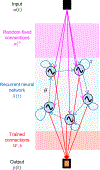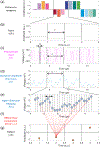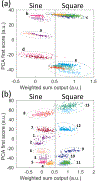Temporal pattern recognition with delayed feedback spin-torque nano-oscillators
- PMID: 32118096
- PMCID: PMC7047780
- DOI: 10.1103/physrevapplied.12.024049
Temporal pattern recognition with delayed feedback spin-torque nano-oscillators
Abstract
The recent demonstration of neuromorphic computing with spin-torque nano-oscillators has opened a path to energy efficient data processing. The success of this demonstration hinged on the intrinsic short-term memory of the oscillators. In this study, we extend the memory of the spin-torque nano-oscillators through time-delayed feedback. We leverage this extrinsic memory to increase the efficiency of solving pattern recognition tasks that require memory to discriminate different inputs. The large tunability of these non-linear oscillators allows us to control and optimize the delayed feedback memory using different operating conditions of applied current and magnetic field.
Figures













References
-
- Hochreiter S and Schmidhuber J, Long Short-term Memory, Neural Comput. 9, 1735 (1997). - PubMed
-
- Schuster M and Paliwal KK, Bidirectional recurrent neural networks, IEEE Trans. Signal Process. 45, 2673 (1997).
Grants and funding
LinkOut - more resources
Full Text Sources
